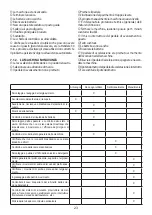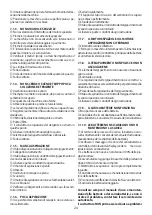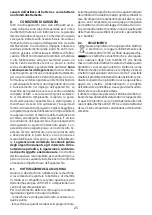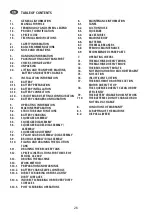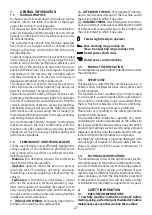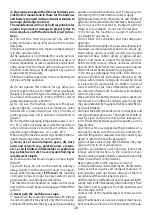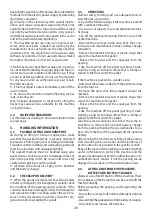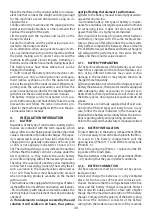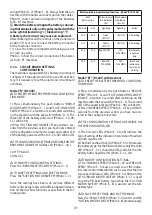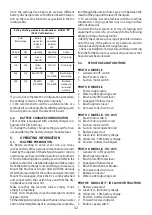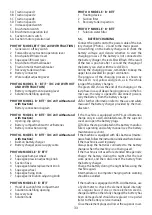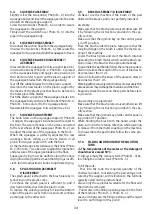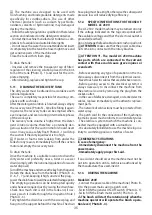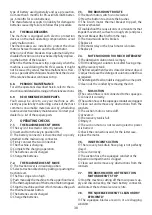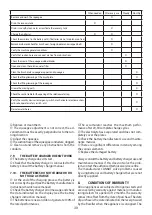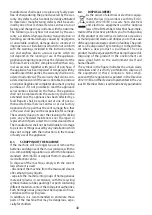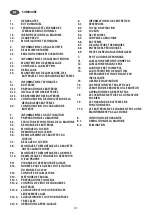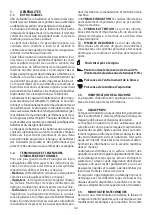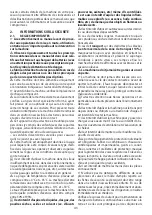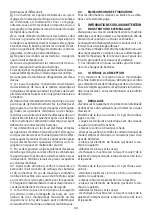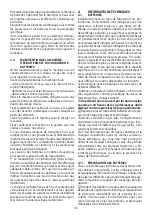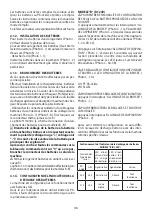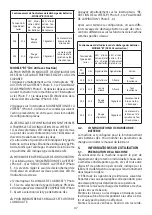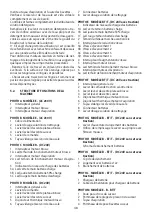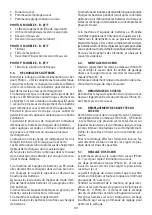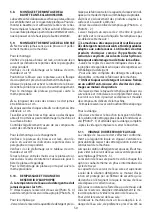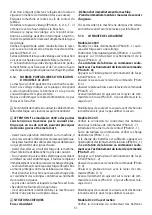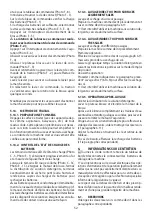
37
squeegee and turn off the suction motor.
Move to a suitable location to drain the tanks; empty
and clean the tanks (as described in 6.11).
Turn off the machine using the key and remove it
from the control panel.
If necessary, charge the battery (see the relative section).
6.
MAINTENANCE INFORMATION
•
Turn the key, remove it from the control panel and
disconnect the battery from the machine wiring.
☞
All work on the electrical system as well as all main-
tenance and repair operations (especially those not
explicitly described in this manual) should be carried
out only by authorized service centers or by special-
ized technical personnel who are experts in the sector
and in the pertinent safety regulations.
Performing regular maintenance on the machine, and
carefully following the manufacturer’s instructions,
is the best guarantee for obtaining the best perfor-
mances and extended machine service life.
6.1.
TANKS
Drain the two tanks as described in the relative sections.
Remove any solid dirt by filling and draining the tanks
until all dirt has been eliminated: use a washing hose
or similar tool to do this.
( ! ) Water hotter than 50°, a high-pressure cleaner or
excessively powerful sprays may damage the tanks
and the machine.
Leave the plugs of the tanks open (only while the ma-
chine is not being used) so that they can dry and thus
prevent the formation of foul odors.
6.2.
SUCTION HOSE
Detach the suction hose from the squeegee ( Photo M - 3).
Now you can wash the hose and remove any obstruc-
tions.
Firmly insert the hose on the squeegee body.
6.3.
SQUEEGEE
•
Do not handle the squeegee with bare hands: wear
gloves and any safety clothing needed to carry out
the operation.
Detach the squeegee from the machine and clean it
under running water using a sponge or a brush.
Check the efficiency and the wear on the strips in con-
tact with the floor. They are designed to scrape the
film of detergent and water on the floor and to isolate
that portion of the surface to enhance the vacuum of
the suction motor: this ensures that the machine will
dry very efficiently. Working constantly in this manner
tends to round or to deteriorate the sharp edge of the
strip, thus reducing drying efficiently. This is why the
squeegee strips must be replaced.
To replace the worn blades, follow the instructions in
the relative section. Turn the blades around to wear
down the other sharp corners or to install new ones.
6.4.
ACCESSORIES
Remove and clean the brushes or the scraper disks.
•
To avoid damaging the floor and the machine,
carefully check if foreign matter, such as metallic
parts, screws, chips, cords or similar items, has be-
come jammed.
Check that the brushes are flat as they work on the
surface (check for any irregular wear on the brushes
or on the abrasive disks). If necessary, adjust the slant
of the action on the floor.
Use only the accessories recommended by the manu-
facturer: other products may reduce operating safety.
6.5.
MACHINE BODY
Use a sponge or a soft cloth to clean the exterior of
the machine and, if necessary, a soft brush to elim-
inate tough dirt. The machine’s shockproof surface
is rough to make it harder to see scratches caused
during use. However, this does not make it easier to
remove tough stains on the surface. It is prohibited to
use steam machines, hoses with running water and
high-pressure cleaners.
6.6.
BATTERIES
PB-Acid batteries
Carry out maintenance operations in accordance with
the manufacturer’s instructions and with all the other
instructions provided in this manual.
Exposing the element plates (not completely im-
mersed in the acid solution) will lead to rapid oxida-
tion and irreparably reduce the element’s operating
capacities.
An overflowing acid solution may corrode the machine.
Use battery chargers recommended by the manufac-
turer and, in any case, those that are suitable for the
type of battery to be charged.
Always charge batteries in well-ventilated rooms:
there is an explosion risk!
Always charge batteries in well-ventilated rooms,
there is a risk of explosion!
The use of gel or maintenance-free batteries is highly
recommended.
GEL batteries
Carry out maintenance operations in accordance with
the manufacturer’s instructions and with all the other
instructions provided in this manual.
Use only those battery chargers recommended by the
manufacturer.
If the batteries are not used, in either case, for an ex-
tended period of time, disconnect them and restore
the charge within the time limits specified for the
Summary of Contents for CPS 50 B
Page 3: ...3 2 1 3 A B 6 1 3 4 5 2 E AC 230V...
Page 4: ...4 C D 2 2A 3A 3B 3C 1A 1 3 6 3 4 5 1 8 2 B DC 24V 7...
Page 6: ...6 H G 1 2 1 3 2 I...
Page 7: ...7 1 2 L M 1 1 4 4 3 2 5 7 6 5 2 6...
Page 8: ...8 N O 1 1 2 3 3 2 4...
Page 9: ...9 P 1...
Page 91: ...91 1 1 1 1 2 2 10 1 3 1 4...
Page 92: ...92 1 5 2 2 1 4 35 10 50 30 95 2 10...
Page 93: ...93 2 2...
Page 94: ...94 3 3 1 3 2 3 3 C C 3 4...
Page 95: ...95 4 4 1 20 20 20h 5 5 5h 5 5 20 20 24 4 1 1 4 1 2 I 2 G 1 3 I 1 I 2...
Page 101: ...101 2 2 2 P 1 5 11 3 1 5 D 6 F 7 3 5 12 AC 230V AC230 AC 230V...
Page 103: ...103 5 14 5 14 1 5 14 2 3 1 3 1 5 14 3 6 13 5 14 4 6 13 6 14 3 5 14 5 6 11 6 6 1 50...
Page 104: ...104 6 2 M 3 6 3 6 4 6 5 6 6 6 7...
Page 105: ...105 6 8 6 8 1 6 8 2 6 8 3 6 9 7 7 1 1 C 7 2 5 7 3...
Page 106: ...106 7 4 7 5 7 6 7 7 7 8 7 9 7 10 100 20 30 8 12...
Page 107: ...107 8 1 2013 56 EU 8 2 2012 19 EU 2012 19 EU...
Page 124: ...124...
Page 125: ...125...
Page 126: ...126...
Page 127: ...127...
Page 128: ...128...
Page 129: ...129...
Page 130: ...130...
Page 131: ...131...
Page 238: ...238 1 1 1 1 2 2 10 1 3 a 1 4...
Page 239: ...239 1 5 2 2 1 4 C 35 C 10 C 50 C 30 95 2 10...
Page 240: ...240 2 2 3 3 1 3 2 3 3...
Page 241: ...241 3 4 4 4 1 Ah 20 C20 20h 5 C5 5h C5 C20...
Page 247: ...247 50 C N 4 N 3 2 N 2 2 L Q 1 5 11 N 3 0 1 B 6 D 6 F 7 0 3 5 12 230V 230V AC 230V...
Page 249: ...249 5 14 2 C 3 E 1 C 3C E 1C 5 14 3 6 13 5 14 4 6 13 6 14 3 5 14 5 6 11 6 6 1 50 6 2 3...
Page 250: ...6 3 250 6 4 6 5 X X X X X X X X X X X X X X X X X X...
Page 251: ...251 6 6 BPb 3 AGM 6 6 7 6 8 6 9 7 7 1 ON 7 2 5 7 3...
Page 252: ...252 7 4 7 5 7 6 7 7 7 8 7 9 7 10 100 20 30 8 12...
Page 253: ...253 8 1 2013 56 8 2 WEEE 2012 19 2012 19 EU...
Page 255: ...255 1 1 1 1 2 2 2 10 1 3 1 4...
Page 256: ...256 1 5 2 2 1 4 C 35 C 10 C 50 C 30 95 2 10...
Page 257: ...257 2 2 134 3 3 1 3 2 3 3...
Page 258: ...258 3 4 4 4 1 4 1 1 Ah 20 C20 20h 5 C5 5h C5 C20...
Page 263: ...263 5 4 M 6 6 M 3 5 5 M 6 5 6 6 5 M 4 M 6 M 4 M 6 6 4 5 7 7 2 45 M 2 M 7 5 8 5 9 1 cm 1 cm...
Page 264: ...264 5 10 50 C N 4 N 3 G 2 N 2 2 cm 5 11 N 3 1 B 6 D 6 F 7 3 5 12 E AC 230V E AC 230V...
Page 267: ...6 2 M 3 6 3 267 X X X X X X X X X X X X X X X X X X...
Page 268: ...268 6 4 6 5 6 6 3 AGM 6 6 7 6 8 6 9 7 7 1 7 1 1 1...
Page 269: ...269 30 7 1 2 5 7 1 3 7 1 4 7 1 5 7 1 6...
Page 270: ...270 7 1 7 7 1 8 7 1 9 7 1 10 100 20 30 8 12 8 1...
Page 271: ...271 2013 56 E 8 2 2012 19 2012 19...

